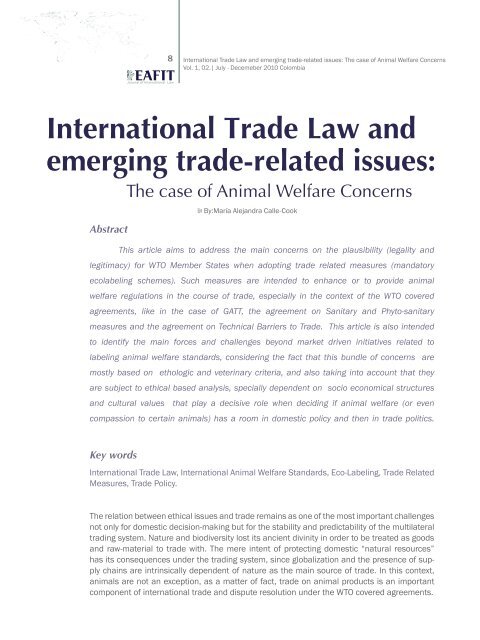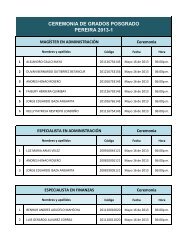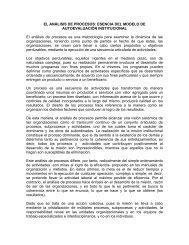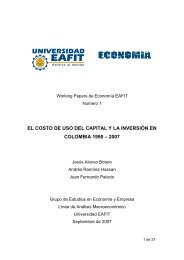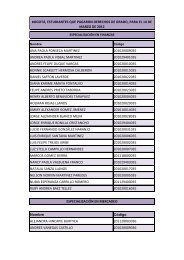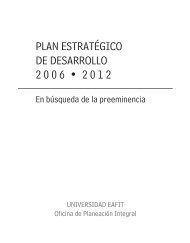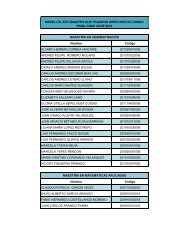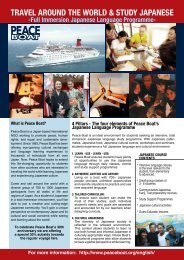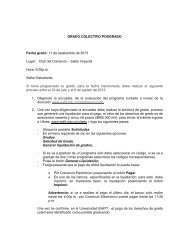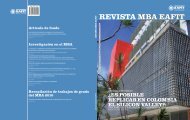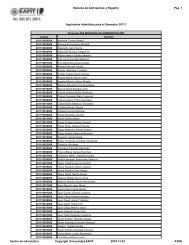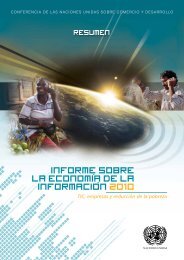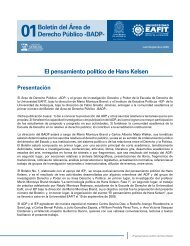International Trade Law and emerging trade-related issues:
International Trade Law and emerging trade-related issues:
International Trade Law and emerging trade-related issues:
You also want an ePaper? Increase the reach of your titles
YUMPU automatically turns print PDFs into web optimized ePapers that Google loves.
8<strong>International</strong> <strong>Trade</strong> <strong>Law</strong> <strong>and</strong> <strong>emerging</strong> <strong>trade</strong>-<strong>related</strong> <strong>issues</strong>: The case of Animal Welfare ConcernsVol. 1, 02.| July - Decemeber 2010 ColombiaJournal of <strong>International</strong> <strong>Law</strong><strong>International</strong> <strong>Trade</strong> <strong>Law</strong> <strong>and</strong><strong>emerging</strong> <strong>trade</strong>-<strong>related</strong> <strong>issues</strong>:The case of Animal Welfare ConcernsAbstractBy:María Alej<strong>and</strong>ra Calle-CookThis article aims to address the main concerns on the plausibility (legality <strong>and</strong>legitimacy) for WTO Member States when adopting <strong>trade</strong> <strong>related</strong> measures (m<strong>and</strong>atoryecolabeling schemes). Such measures are intended to enhance or to provide animalwelfare regulations in the course of <strong>trade</strong>, especially in the context of the WTO coveredagreements, like in the case of GATT, the agreement on Sanitary <strong>and</strong> Phyto-sanitarymeasures <strong>and</strong> the agreement on Technical Barriers to <strong>Trade</strong>. This article is also intendedto identify the main forces <strong>and</strong> challenges beyond market driven initiatives <strong>related</strong> tolabeling animal welfare st<strong>and</strong>ards, considering the fact that this bundle of concerns aremostly based on ethologic <strong>and</strong> veterinary criteria, <strong>and</strong> also taking into account that theyare subject to ethical based analysis, specially dependent on socio economical structures<strong>and</strong> cultural values that play a decisive role when deciding if animal welfare (or evencompassion to certain animals) has a room in domestic policy <strong>and</strong> then in <strong>trade</strong> politics.Key words<strong>International</strong> <strong>Trade</strong> <strong>Law</strong>, <strong>International</strong> Animal Welfare St<strong>and</strong>ards, Eco-Labeling, <strong>Trade</strong> RelatedMeasures, <strong>Trade</strong> Policy.The relation between ethical <strong>issues</strong> <strong>and</strong> <strong>trade</strong> remains as one of the most important challengesnot only for domestic decision-making but for the stability <strong>and</strong> predictability of the multilateraltrading system. Nature <strong>and</strong> biodiversity lost its ancient divinity in order to be treated as goods<strong>and</strong> raw-material to <strong>trade</strong> with. The mere intent of protecting domestic “natural resources”has its consequences under the trading system, since globalization <strong>and</strong> the presence of supplychains are intrinsically dependent of nature as the main source of <strong>trade</strong>. In this context,animals are not an exception, as a matter of fact, <strong>trade</strong> on animal products is an importantcomponent of international <strong>trade</strong> <strong>and</strong> dispute resolution under the WTO covered agreements.
<strong>International</strong> <strong>Trade</strong> <strong>Law</strong> <strong>and</strong> <strong>emerging</strong> <strong>trade</strong>-<strong>related</strong> <strong>issues</strong>: The case of Animal Welfare ConcernsJuly - Decemeber 2010 Colombia| Vol.1, 02.9Journal of <strong>International</strong> <strong>Law</strong>According to Weiss, even more is expected of the contemporary world trading system forwhich the WTO provides the common institutional framework <strong>and</strong> its main negotiating forumincreasingly, that system intersects with <strong>issues</strong> directly affecting peoples’ lives, such as investment<strong>and</strong> competition policies, environmental <strong>and</strong> development policies. Human rights,labor, st<strong>and</strong>ards, health, animal welfare, distribution of resources, ethical <strong>issues</strong>, <strong>and</strong> evennational security. All these <strong>issues</strong> are raised with ‘sovereignty of purpose’ by particular interestgroups seeking regulatory intervention, unconcerned about possible ‘limits to the growth’<strong>and</strong> utility of such activity in the global economy. 1Many <strong>trade</strong> <strong>related</strong> <strong>issues</strong> are strongly <strong>related</strong> to social <strong>and</strong> cultural identity. Recent <strong>trade</strong>disputes dealing with food (use of artificial growth hormones in beef production <strong>and</strong> applicationof biotechnology –GMOs) are particularly grounded in the cultural perceptions <strong>and</strong> socialmeaning of food (resistance towards artificial growth hormones <strong>and</strong> GM-food is in this sensenot strictly science based but also culture based). 2 In the same way, animal welfare st<strong>and</strong>ardsor animal-cruelty awareness among consumers is deeply enrooted in culture <strong>and</strong> socio economicalrealities. Thus, if such values (concerns) exist in a given society, citizens (consumers<strong>and</strong> taxpayers) have the legitimacy to dem<strong>and</strong> governmental intervention in order to protecttheir concerns even if third countries expectations <strong>related</strong> to <strong>trade</strong> are at stake.In this sense, the basis of animal welfare ideas could be described as the moral considerationof animals as sentient beings. Embedded in philosophic <strong>and</strong> ethical theories 3 such asBentham´s Utilitarian approach, the rationale of this notion is not merely posing the question of ifanimals can reason but if they can experiment suffering. 4 According to this approach, the capacityto feel pain will be the condition to identify interests in animals (e.g. pain, stress <strong>and</strong> fear).The central point that can be extracted from Bentham´s <strong>and</strong> Singer´s argument is that animalinterests should be –prima facie- considered in the course of moral deliberation as animalinterest in avoiding pain are very similar to those of humans. Drawing the line at interests-inpain <strong>and</strong> displeasure-is seen a the only possible line of demarcation as all other supposedly1 Weiss, F, 2006. “The limits of the WTO: Facing non-<strong>trade</strong> <strong>issues</strong>”, in Sacerdoti, G, Bohanes, J, Yanovich, A. (eds.), The WTO at 10: The Roleof the Dispute Settlement System, Cambridge University Press, WTO, May 2006.2 See Brom, Frans “WTO, Public Reason <strong>and</strong> Food, public reasoning in <strong>trade</strong> conflict on GM-Food”. 20043 ‘Philosophers, theologians, <strong>and</strong> others have long debated the interrelationships between man <strong>and</strong> animals in terms of the position <strong>and</strong>role of animals in the world, the obligations of man towards them (if any) <strong>and</strong> the uses to which animals should be put. Much of the earlywritings on these matters took the ethical position that animals exist for the sake of man (e.g., Aristotle) <strong>and</strong> that man can, <strong>and</strong> should, useanimals anyway that he pleases (e.g., Saint Thomas Aquinas). Indeed, some writers have gone as far as asserting that animals are nothingmore than machines that lack speech <strong>and</strong> hence cannot reason (e.g., Rene Descartes). Regan <strong>and</strong> Singer (1989) provide a useful briefreview of these early writings. The more-recent debate has centered largely around animal sentience <strong>and</strong> cognition, various forms of utilitarianism<strong>and</strong> contractualism <strong>and</strong> how they relate to the question of rights. In his well-known treatise, Jeremy Bentham (Bentham, 1789),the “father” of utilitarianism, contends that the key issue is that animals are capable of pleasure <strong>and</strong> pain. He writes that “animals st<strong>and</strong>degraded into the class of things” <strong>and</strong> states that “the day may come, when the rest of the animal kingdom may acquire those rights whichnever could have been withholder from them but by the act of tyranny” (Bentham, 1789, p. 283).’ (Bennet et al, 2002:187-88)4 See, Bentham, J., An Introduction to the Principles of Morals <strong>and</strong> Legislation (Rusell, London, 1962)
<strong>International</strong> <strong>Trade</strong> <strong>Law</strong> <strong>and</strong> <strong>emerging</strong> <strong>trade</strong>-<strong>related</strong> <strong>issues</strong>: The case of Animal Welfare ConcernsJuly - Decemeber 2010 Colombia| Vol.1, 02.11Journal of <strong>International</strong> <strong>Law</strong>alleviation of pain <strong>and</strong> suffering, <strong>and</strong> the ability to enjoy minimal movement. ‘Such obligationsare reflected in the so-called “five freedoms” elaborated by the Brambell Committee ofthe U.K. Parliament in 1965 <strong>and</strong> in subsequent conventions on animal welfare agreed in theCouncil of Europe.5 These conventions have been extremely important in guiding legislationon animal welfare in the European Union.’ 8In this context, the World Organization for Animal Health emerges as the international-settingst<strong>and</strong>ard body for animal welfare. Therefore, it is possible to say that even if this topic havebeen studied <strong>and</strong> presented as a low-profile issue, their implications to <strong>trade</strong> liberalizationshall not been underestimated . Especially because the driven force that increasingly advocatesfor animal welfare as a <strong>trade</strong> <strong>related</strong> issue is based on consumer´s autonomy <strong>and</strong> insome cases, as a “policy space” matter (animal welfare st<strong>and</strong>ards are commonly regulated bydomestic legislation). In other words, animal welfare st<strong>and</strong>ards are often perceived as a Non<strong>Trade</strong> Barrier in WTO jargon.Moreover, market driven responses <strong>and</strong> constituencies claims over governments are increasinglyconsisting in ethical <strong>and</strong> cultural concerns. According to Hobbs, as concerns relating toethical <strong>issues</strong> in production have increased for some consumers, so too have dem<strong>and</strong>s forinformation concerning production methods. Intense lobbying efforts by non-governmental organizations(NGOs) have been the most visible manifestation of these dem<strong>and</strong>s. In responseto these efforts, the EU has adopted a new <strong>and</strong> more stringent set of legislative initiatives regardingthe welfare of animals. Council Directive 98/58/EC is the main law protecting animalskept for farming purposes; it lays down st<strong>and</strong>ards for the conditions in which farm animal areto be kept <strong>and</strong> bred in Member States. Additional legislation exists regarding the protection oflaying hens <strong>and</strong> veal calves. The Treaty of Amsterdam also contains a protocol on the Protection<strong>and</strong> Welfare of Animals. 9Thus, Animal welfare concerns are arguably interpreted as <strong>trade</strong> barriers-disguised protectionism-,but nevertheless it is also plausible to say that they might be also considered aslegitimate domestic responses to common concerns embedded inter alia in ‘laws restrictingimport of (specimens of) endangered animals, skins, of pups of harp <strong>and</strong> hooded seals<strong>and</strong> derived products, wild birds, cosmetic tested on animals, animals transported underinhumane conditions, meat from animals slaughtered or transported in “inhumane” ways, orshrimp caught in a way that harmed endangered sea turtles..’ 108 Blanford, David, Bureau, J.C., Fulponi, Linda, Henson, Spencer. Potential implications of animal welfare concerns public policies in industrializedcountries for <strong>International</strong> <strong>Trade</strong>.9 Hobbs, A.L., Hobbs, Jill E., Isaac, G.E., Kerr, William, A., 2002. Ethics , domestic food policy <strong>and</strong> <strong>trade</strong> law: assessing the EU animal welfareproposal to the WTO. Food policy 27, 437-54.10 Nollkaemper André, “The Legality of Moral Crusades Disguised in <strong>Trade</strong> <strong>Law</strong>: an analysis of the ec ‘ban’ on furs from animals taken byLeghold traps”, Journal of Environmental <strong>Law</strong>, vol.8, issue.2, 1996, p.237-256
12<strong>International</strong> <strong>Trade</strong> <strong>Law</strong> <strong>and</strong> <strong>emerging</strong> <strong>trade</strong>-<strong>related</strong> <strong>issues</strong>: The case of Animal Welfare ConcernsVol. 1, 02.| July - Decemeber 2010 ColombiaJournal of <strong>International</strong> <strong>Law</strong>Unilateral attempts in setting Animal Welfare St<strong>and</strong>ards: Merciful vindicationor hidden protectionism?According to Matsushita, Shoenbaum & Mavroidis 11 , there are four schemes in which <strong>trade</strong><strong>and</strong> market access barriers can be grouped. The first scheme is <strong>related</strong> to governmentalborder measures (tariffs, quotas, customs regulations, import licensing, testing <strong>and</strong> certifications).The second scheme includes internal regulations <strong>and</strong> practices that have potentialprotective effects. Those regulations usually include certain conditions <strong>related</strong> to product <strong>and</strong>services, distribution channels, technical st<strong>and</strong>ards, subsidies, state-trading monopolies, <strong>and</strong>bio-security measures. The third scheme relates to private business practices <strong>and</strong> customsaffecting business behavior <strong>and</strong> consumer preferences, whereas the forth scheme includeseconomic <strong>and</strong> structural characteristics of the importing country (government credit, macroeconomic,investment <strong>and</strong> industrial policies).However is not upon the WTO to reach all those categories in the sense that “the WTO hastended to concentrate on explicit <strong>and</strong> obvious governmentally imposed <strong>trade</strong> obstacles, suchtariffs, quotas <strong>and</strong> customs regulations <strong>and</strong> practices. In the later rounds on <strong>trade</strong> negotiations,however, notably the Tokyo <strong>and</strong> Uruguay Rounds, the WTO addressed less obviousgovernmental measures, such as import licensing, subsidies <strong>and</strong> technical barriers to <strong>trade</strong>.Nevertheless, many <strong>trade</strong> barriers remain outside the purview of the WTO agreements” 12Domestic regulations on animal welfare matters are often included seem as technical barriersto <strong>trade</strong>. These types of regulations are nothing different from requirements <strong>related</strong> tocertain characteristics that products should meet in order to be allowed within the market. Itis important to say that technical regulations are not considered as barriers per se under theWTO law. That is to say that in order to be considered as barrier, a regulation must been unrealisticor unreasonable <strong>and</strong> the procedures to verify compliance with those regulations couldbe also considered as barriers according to their nature. In some cases the barrier lingers onthe proliferation of non st<strong>and</strong>ardized certification processes.In order to solve those kinds of problems, the Agreement on Technical Barriers to <strong>Trade</strong> (hereinafterTBT) seeks to strike a balance between the policy space of Member States <strong>and</strong> thediscipline that such measures must observe in order to minimize their impact on <strong>trade</strong> liberalization.According to the TBT Agreement “technical regulations” are “m<strong>and</strong>atory laws orprovisions specifying the characteristics of products, the processes or production methodsfor creating products or the terminology, symbols, packaging, marking, or labeling requirementsfor products.” 13 Additionally, “the TBT Agreement requires the WTO members to applynational treatment <strong>and</strong> MFN st<strong>and</strong>ards with respect to technical regulations. It also requires11 Matsushita, Mitsuo., Schoenbaum, Thomas J., <strong>and</strong> Mavroidis, Petros C. The WTO <strong>Law</strong>, Practice <strong>and</strong> Policy, USA, Oxford University Press,2003, p.258-28512 Ibíd., p.258-25913 TBT Agreement, Annex.1, para.1, p.16
<strong>International</strong> <strong>Trade</strong> <strong>Law</strong> <strong>and</strong> <strong>emerging</strong> <strong>trade</strong>-<strong>related</strong> <strong>issues</strong>: The case of Animal Welfare ConcernsJuly - Decemeber 2010 Colombia| Vol.1, 02.13Journal of <strong>International</strong> <strong>Law</strong>WTO members to use international st<strong>and</strong>ards when such st<strong>and</strong>ards are available, exceptwhen such st<strong>and</strong>ards would be an ineffective or inappropriate means for the fulfillment of thelegitimate objectives pursued.” 14 Furthermore, technical regulations must fulfill certain requisitesin terms of: transparency, prompt publication (to make them generally available), shallno create “unnecessary obstacles to international <strong>trade</strong>” or been “more <strong>trade</strong>-restrictive thatnecessary to fulfill a legitimate objective”. 15 It is still problematic if the above mentioned definitionwill include the polemical non-production-<strong>related</strong> st<strong>and</strong>ards <strong>and</strong> most generally ProductProduction Methods (hereinafter PPMs) in which animal welfare concerns have their mostprominent expression. 16In relation to adoption preparation <strong>and</strong> application of st<strong>and</strong>ards, the TBT also contain a Codeof Good Practices. In this Code, the term st<strong>and</strong>ard is defined as a voluntary guideline for characteristicof products 17 (Annex 1, para.2) <strong>and</strong> requires Member States to participate in <strong>and</strong>comply with st<strong>and</strong>ards code being formulated by international bodies like the <strong>International</strong>Organization for St<strong>and</strong>ardization (ISO). Nevertheless, this organization is not certainly deeply<strong>related</strong> with ecological <strong>issues</strong> or animal welfare. Animal welfare often assumes the form fortechnical regulations <strong>and</strong> st<strong>and</strong>ards embedded in eco-labeling initiatives.The eco-labeling case in animal welfare is becoming quite popular as a market driven mechanismto pursue ethical values <strong>related</strong> to environmental protection.In this sense it is possible to say that ecological labels are market-based environmental policyinstrument informing consumers about environmental characteristics of goods. Labels aregranted by different private or governmental organizations to producers for different productcategories. Many eco-labels not only inform about product quality itself, but also the wholelife cycle, including generation of inputs, production processes, consumption <strong>and</strong> waste disposal.The number of countries applying eco-labels has been growing constantly. However,14 Matsushita, Op. cit., p.27915 According to the TBT Agreement, those objectives include concerns to: National security requirements, prevention of deceptive practices,protection of human health or safety, animal or plant life or health <strong>and</strong> environment.16 According to Dröge, is not that clear “whether non-product-<strong>related</strong> st<strong>and</strong>ards, which are applied in life cycle labeling schemes, are subjectto TBT-rules. The definition in Annex 1.2 TBT names ‘products or <strong>related</strong> processes <strong>and</strong> production methods’. An interpretation has toconsider the negotiation history of the agreement. Chang (1997; 147) states that non-product-<strong>related</strong> PPMs were explicitly excluded,already during the negotiation of the amendment to the TBT-Agreement, <strong>and</strong> thus cannot be considered when interpreting the text. Duringnegotiations of the Uruguay-Round, negotiators used the expression ‘or <strong>related</strong>’ in order to exclude ‘non-<strong>related</strong>’ processes <strong>and</strong> productionmethods. According to these findings, non-product-<strong>related</strong> criteria in eco-labeling schemes are not covered by TBT-rules for st<strong>and</strong>ards <strong>and</strong>technical regulations <strong>and</strong> are therefore to date not a valid criterion to differentiate otherwise like products…Should there be any dispute,the TBT-Agreement would only cover those parts of labeling programs that determine product or product-<strong>related</strong> criteria. Such criteria couldthen be justified for both voluntary <strong>and</strong> obligatory labels with reference to the TBT preamble. More specifically, for compulsory schemes acountry can refer to Article 2.2 TBT which names ‘the environment’ as a legitimate objective for which a certain degree of <strong>trade</strong> restrictionscould be justified. However, also the requirement of non-discrimination between like products from national origin <strong>and</strong> abroad (Article 2.1TBT) needs to be fulfilled.’(Dröge 2001:11)17 TBT Agreement, Annex.1, para.2, p.16
14<strong>International</strong> <strong>Trade</strong> <strong>Law</strong> <strong>and</strong> <strong>emerging</strong> <strong>trade</strong>-<strong>related</strong> <strong>issues</strong>: The case of Animal Welfare ConcernsVol. 1, 02.| July - Decemeber 2010 ColombiaJournal of <strong>International</strong> <strong>Law</strong>with the increasing international integration, especially growth in <strong>trade</strong> in goods <strong>and</strong> services,consumers as well as producers dem<strong>and</strong> compatibility <strong>and</strong> transparency of labels on an internationallevel. Also, eco-labels from industrialized countries are subject to increasing criticismfrom developing countries, which regard labels as a new non-tariff <strong>trade</strong> barrier. 18From the analysis of the TBT Agreement it is evident that consequences of both dimensions–technical regulations <strong>and</strong> ecol-labeling initiatives- would have different impacts due to thevoluntary nature whereas technical regulations are compulsory. According to Dröge, ‘criteriafor voluntary eco-labeling can be interpreted as st<strong>and</strong>ards <strong>and</strong> those in m<strong>and</strong>atory schemesas technical regulations’ 19When trying to find an alternative mechanism to avoid possible unilateralism in this type ofmeasures (design <strong>and</strong> implementation of technical st<strong>and</strong>ards or eco-labeling schemes <strong>related</strong>to animal welfare) the most evident <strong>and</strong> popular option is usually linked to multilateralsefforts intended to negotiate an international agreement on animal welfare or even the creationof an organization in the similar fashion of ISO, in order to harmonize the different criteriawhen measuring animal welfare st<strong>and</strong>ards <strong>related</strong> to <strong>trade</strong>. However, According to Hobbs‘this alternative of having such organization to establish a baseline international st<strong>and</strong>ard isunlikely to satisfy the EU because any common st<strong>and</strong>ard agreeable to developing countrieswould be too low to satisfy concerned EU consumers.’ 20 However, even if an internationalagreement on animal welfare is unlikely to be challenged in the WTO, the volumes of <strong>trade</strong>that could be affected will be considerable. 21Animal welfare as a <strong>trade</strong> policy issue driven by consumer activismHaving an international agreement on animal welfare matters is often seen as a real utopia,nevertheless, the Agreement on <strong>International</strong> Humane Trapping St<strong>and</strong>ards between the EuropeanCommunity, Canada <strong>and</strong> the Russian Federation <strong>and</strong> the <strong>International</strong> Agreement inthe form of an Agreed Minute between the European Community <strong>and</strong> the United States on humanetrapping st<strong>and</strong>ards, may be regarded as the first international agreements concernedexclusively with animal welfare 2218 Dröge, Susan, 2001. Ecological labeling <strong>and</strong> the world <strong>trade</strong> organization. Deutsches Institut Für Wirtschaftsforschung, berlin. Discussionpaper No. 242, 2-29.19 Ibíd.20 Hobbs, A.L., Hobbs, Jill E., Isaac, G.E., Kerr, William, A., 2002. Ethics , domestic food policy <strong>and</strong> <strong>trade</strong> law: assessing the EU animal welfareproposal to the WTO. Food policy 27, 437-54.21 ‘It is possible that the <strong>trade</strong> provisions of an animal welfare agreement would not be challenged at the WTO (Isaac et al., 2002). This hasbeen the case for the (CITES). However, the volumes of <strong>trade</strong> affected by CITES are small. In the case of products covered by animal welfareregulations, the volumes of <strong>trade</strong> affected could be very large <strong>and</strong> countries who feel aggrieved will likely use the option to defer to the WTOgiven the lack of clarity over which international agreement would have primacy.’(Hobbs et al., 2002:448)22 Stuart R Harrop, “The Agreements on <strong>International</strong> Humane Trapping St<strong>and</strong>ards –Background, Critique <strong>and</strong> the Texts”, Journal of <strong>International</strong>Wildlife <strong>Law</strong> & Policy, vol.1, núm.3, 1998, p.387-394
<strong>International</strong> <strong>Trade</strong> <strong>Law</strong> <strong>and</strong> <strong>emerging</strong> <strong>trade</strong>-<strong>related</strong> <strong>issues</strong>: The case of Animal Welfare ConcernsJuly - Decemeber 2010 Colombia| Vol.1, 02.15Journal of <strong>International</strong> <strong>Law</strong>Nevertheless, multilateral efforts are deemed necessary to address the importance of animalwelfare concerns as <strong>trade</strong> <strong>related</strong> <strong>issues</strong> (especially for consumers). In the frequent reactionin order to enforce environmental st<strong>and</strong>ards <strong>and</strong> act accordingly consumer´s dem<strong>and</strong>s bymeans of <strong>trade</strong> policy responses, governments generally fall in unilateralism an sometimes indouble morals arguments, which generally arises the discontent of other countries –particularlydeveloping countries- in the sense that such actions are perceived as nothing differentform the projection of the own countries’ values, (even the mercifulness over certain species).“The US government (<strong>and</strong> to some extent the European Union) falls back on unilateral actionbecause there is no established international mechanism to enforce environmental st<strong>and</strong>ardsor policies. Moreover, the need to achieve unanimity for decisions taken in the internationalrealm can make multilateral agreements bl<strong>and</strong>, inoffensive, <strong>and</strong> ineffectual.The intrinsic difficulty of multilateral decision making <strong>and</strong> the lack of existing institutionalstructures for effective international environmental policymaking therefore makes unilateralaction a necessary, if unfortunate, policy option in some circumstances. Even Robert Hudec,accepts the inevitability of some unilateral actions, concluding that under certain circumstances,intentional disregard of GATT obligations may be useful in ‘breaking legal deadlocksad stimulating improvements in GATT law. Such justified disobedience should, in Hudec’sview, be conditioned by a requirement that the disobeying country imposes the same st<strong>and</strong>ardon itself that it seeks to m<strong>and</strong>ate for others.’ 23In this context the tension between domestic policy, morals <strong>and</strong> <strong>trade</strong> liberalizationemerge when understating the rationale <strong>and</strong> the consequences of animal welfare st<strong>and</strong>ards.What issue should prevail upon the other? The WTO has been traditional produceroriented even if some the ideas of democracy <strong>and</strong> inclusion of the civil society has beencommon components of its discourse, nevertheless this topic will be driven by consumers.How ready is the WTO to attend certain governmental measures motivated by nothingdifferent of moral <strong>and</strong> philosophical questions?Contrasting Etsy´s view, Charnovitz pose additional questions: should local morals be able totrump economic globalization? Should international morals be able to trump the exercise of powerby local elites? 24 Policymakers trying to answer these questions will want to examine the potentialeffectiveness of <strong>trade</strong> measures as well as their legality under international <strong>trade</strong> rules. Assessingeffectiveness requires a specification of the moral goal -…. Once the goal is specified, an importantvariable will be the number of states involved. Multilateral action will probably be more effective ifthe goal is to change behavior. With unilateral action, the potential usefulness of a <strong>trade</strong> measurecan be undercut through <strong>trade</strong> diversion. As one political scientist explained, “[a] single state mayadopt what it deems to be effective measures to combat certain evils, only to find that its policiesare largely defeated by the failure of neighboring states to adopt similar measures.” 2523 Esty, Daniel, C., 1994. Greening the GATT: <strong>Trade</strong>, Environment, <strong>and</strong> the Future. Institute for <strong>International</strong> Economics. Washington, DC.24 Charnovitz, Steve. 1998. The Moral Exception in <strong>Trade</strong> Policy. Virginia Journal of <strong>International</strong> <strong>Law</strong>. 38 Va. J. Int’L. 689.25 Ibíd.
16<strong>International</strong> <strong>Trade</strong> <strong>Law</strong> <strong>and</strong> <strong>emerging</strong> <strong>trade</strong>-<strong>related</strong> <strong>issues</strong>: The case of Animal Welfare ConcernsVol. 1, 02.| July - Decemeber 2010 ColombiaJournal of <strong>International</strong> <strong>Law</strong>Thus, moral dialogs <strong>and</strong> consumer concerns are inevitable for governments; consumers expressthem in order to give voice to their moral beliefs <strong>and</strong> ideals. According to Meijboom<strong>and</strong> Brom, governments <strong>and</strong> industries, therefore, cannot adequately deal with consumerconcerns without engaging in a moral dialogue about these concerns. Answering the questionwhether consumer concerns are reconcilable with the current WTO framework remainsproblematic. Some consumers happen to fit perfectly within the current WTO aims. 26In this context, it is important to say that environmental protection <strong>and</strong> animal welfare are differentbut interdependent concerns <strong>and</strong> also that every action intended to protect the naturehas an ethical dimension. 27 The so called animal welfare st<strong>and</strong>ards are intrinsically moraloriented concerns <strong>and</strong> hence, the awareness upon animal life is not necessarily driven by anenvironmental aim (although it is scientifically argued that animal welfare st<strong>and</strong>ards have adeep implication on human <strong>and</strong> animal life <strong>and</strong> health). Therefore, the question of animals<strong>and</strong> the WTO entails a complex multidimensional approach: philosophical, legal <strong>and</strong> economical.Animal welfare <strong>issues</strong> are a relevant for the international <strong>trade</strong> law <strong>and</strong> therefore to the WTO,especially because those concerns could be addressed as a “legitimate policy objective” beinginvoked as public morals <strong>issues</strong> <strong>and</strong> in this sense being considered as <strong>trade</strong> barriers (independentlyof its successful inclusion on Article XX of GATT). Animal welfare concerns mayproduce different <strong>trade</strong> measures - <strong>trade</strong> barriers- inter alia. bans on imports of furs <strong>and</strong> peltsfrom wild animals skinned alive (foxes, raccoons, ermines, seals, etc); bans on import of furs<strong>and</strong> pelts form domesticated animals (cats <strong>and</strong> dogs) bans on furs <strong>and</strong> pelts from animalscaught in leg-hold traps, etc. This <strong>trade</strong> measures are often motivated in the process of productionrather than in the product.However under the WTO, ‘members may not be allowed to enact or maintain <strong>trade</strong> barriers toprotect animals in the course of <strong>trade</strong>. The legality of <strong>trade</strong> measures depends on the analysisof the General Exceptions in GATT Article XX because <strong>trade</strong> barriers, most likely, violate thesubstantive obligations under the GATT.’ 2826 Vedder, A, 2003. The WTO <strong>and</strong> concerns regarding animals <strong>and</strong> nature. Nijmegen: Wolf legal publishers, 173-82.27 To underst<strong>and</strong> why environmental protection has an ethical dimension it is important to mention the impact of theories as the “RadicalEcology” when interpreting the international environmental problematique. In this sense, “Radical ecology devolves into two parts. The firstknown as `deep ecology ´<strong>and</strong> the second as social ecology´. Very briefly, deep ecology is concerned with why the environment is protected,whereas social ecology is concerned with how to achieve this end..Deep ecology is also known as `l<strong>and</strong> ethics ´or holistic environmentalethics. By virtue of the fact that deep ecology has evolved from the works of a number of theorists it is not a theory that is rigidly defined.There is however one common feature that is often agreed by all the relevant theorists, namely that environmental protection must bebased upon the inherent (or intrinsic) value of non-human Nature. This is in contrast to what is known as `shallow environmentalism´whichjustifies environmental protection on the grounds that Nature has an instrumental value to humans. This position, which revolves aroundanthropocentrism, proclaims that only humanity has an inherent value. It is this shallow environmentalism that forms the predominantbasis of international environmental law <strong>and</strong> policy” (GILLESPIE, Alex<strong>and</strong>er. 1997: 2)28 Laura Nielsen, “The WTO & Animal Welfare: Sufficient Nexus” for Morally Based NPR-PPMs in GATT Article XX?”, ELSA SPEL(2004, ed. 1),pag.3, [on line], 2004, available in: http://www.elsa.org/fileadmin/user_upload/elsa_international/PDF/SPEL/SPEL_2004-I-NIELSEN.pdf
<strong>International</strong> <strong>Trade</strong> <strong>Law</strong> <strong>and</strong> <strong>emerging</strong> <strong>trade</strong>-<strong>related</strong> <strong>issues</strong>: The case of Animal Welfare ConcernsJuly - Decemeber 2010 Colombia| Vol.1, 02.17Journal of <strong>International</strong> <strong>Law</strong>The most famous WTO cases <strong>related</strong> to animal protection are Tuna/Dolphin 29 <strong>and</strong> Shrimp/Turtle 30 which have been by far the most polemic WTO precedents when addressing <strong>trade</strong><strong>related</strong> <strong>issues</strong>. Those cases were mostly defended on environmental concerns rather thananimal welfare matters, since the main interest was the conservation of the species (conservationof exhaustible natural resources 31 ) rather the “humanity” or “morality” of the way inwhich those animals were killed; in other words, the cases were less connected to the “animalrights philosophy” than with international environmental principles. Nevertheless it is possibleto affirm that even in the absence of “official” records in animal welfare cases under the DisputeSettlement Underst<strong>and</strong>ing, many potential disputes are about to come to the attention ofthe WTO, like in the case of the recent seal ban adopted by the EU which have again arisen thegreen tension <strong>and</strong> bitter responses from the governments of Canada, Norway <strong>and</strong> Greenl<strong>and</strong>.As a concussion, it is possible to say that animal welfare <strong>and</strong> environment protection of animalshave been waiting too long for their floor in Agriculture <strong>and</strong> NAMA, 32 multilateral negotiations<strong>and</strong> the covered agreements of the WTO (specially the SPS33 <strong>and</strong> the TBT34), includingthe Dispute Settlement Mechanism. These multilateral tracks for dealing with animal welfare<strong>and</strong> environmental protection should be interpreted as the iceberg’s point since bilateral negotiations(especially in FTA´s <strong>and</strong> RTA´s) could deal with similar concerns in a wider <strong>and</strong>deeper context which may includes inter alia: eco-labeling, general exceptions, technical st<strong>and</strong>ardsfor products <strong>and</strong> processes (PPM´s <strong>and</strong> its impact in GATT <strong>and</strong> GATS interpretation).29 United States-Restrictions on Imports of Tuna, DS29/R, 16 June 1994. Reprinted in 33 I.L.M. 839 (1994) (unadopted) [hereinafter TunaDolphin II].30 U.S – Import Prohibition of Certain Shrimp <strong>and</strong> Shrimp Products, WT/DS58/R (1998). Appellate Body Report [hereinafter Shrimp-Turtle].31 GATT Article XX (g)32 Non-agricultural Market Access.33 SPS st<strong>and</strong>s for the WTO agreement on Sanitary <strong>and</strong> Phyto-sanitary measures34 TBT st<strong>and</strong>s for WTO agreement on Technical Barriers to <strong>Trade</strong>
18<strong>International</strong> <strong>Trade</strong> <strong>Law</strong> <strong>and</strong> <strong>emerging</strong> <strong>trade</strong>-<strong>related</strong> <strong>issues</strong>: The case of Animal Welfare ConcernsVol. 1, 02.| July - Decemeber 2010 ColombiaJournal of <strong>International</strong> <strong>Law</strong>BibliographyAnimal Welfare Approved http://www.animalwelfareapproved.org/st<strong>and</strong>ards/ Accessed August8, 2009.Bennett, Richard, M., 1997. Farm animal welfare <strong>and</strong> food policy. Food policy, 22 (4), 281-88. (ARTI)Bennet, Richard, M., Anderson, J., Blaney, R. J. P. 2002. Moral intensity <strong>and</strong> willingness to payconcerning farm animal welfare <strong>issues</strong> <strong>and</strong> the implications for the agricultural policy. Journalof Agricultural <strong>and</strong> Environmental Ethics 15, 187-202.Bentham, J., An Introduction to the Principles of Morals <strong>and</strong> Legislation (Rusell, London, 1962)Blanford, David, Bureau, J.C., Fulponi, Linda, Henson, Spencer. Potential implications of animalwelfare concerns public policies in industrialized countries for <strong>International</strong> <strong>Trade</strong>.Brom, Frans, W., A. 2004. WTO, public reason <strong>and</strong> food public reasoning in the ‘<strong>Trade</strong> Conflict’on GM-FOOD. Ethical Theory <strong>and</strong> Moral Practice, 417-31.Bureau, Jean, C., Marette, Sthepan, Schiavina, Aless<strong>and</strong>ra. 1998. Non-tariff barriers <strong>and</strong> consumers’information: The case of the EU-US <strong>trade</strong> dispute over beef. European review of agriculturaleconomics 25, 437-62.Charnovitz, Steve. 1998. The Moral Exception in <strong>Trade</strong> Policy. Virginia Journal of <strong>International</strong><strong>Law</strong>. 38 Va. J. Int’L. 689.Curtin Tom. Managing Green Issues. Palgrave Macmillan 2007.Dröge, Susan, 2001. Ecological labeling <strong>and</strong> the world <strong>trade</strong> organization. Deutsches InstitutFür Wirtschaftsforschung, berlin. Discussion paper No. 242, 2-29.Ecolabeling.org, Who’s deciding what’s green? http://ecolabelling.org/ecolabel/milieukeurecolabel-the-netherl<strong>and</strong>sAccessed August 8, 2009.Ecological Justice: Environmental st<strong>and</strong>ards <strong>and</strong> consumer protection.178.Ecologo program, Third-party certification of environmentally-preferable products http://www.terrachoice-certified.com/en/ Accessed August 8, 2009.Ecomark Scheme of India. A Scheme on labeling of environment-friendly products. http://envfor.nic.in/cpcb/ecomark/ecomark.html Accessed August 8, 2009.Emslie, John J., 2005. Labeling Programs as reasonably available least restrictive <strong>trade</strong> measureunder Article XX´s Nexus requirement.
<strong>International</strong> <strong>Trade</strong> <strong>Law</strong> <strong>and</strong> <strong>emerging</strong> <strong>trade</strong>-<strong>related</strong> <strong>issues</strong>: The case of Animal Welfare ConcernsJuly - Decemeber 2010 Colombia| Vol.1, 02.19Journal of <strong>International</strong> <strong>Law</strong>Environmental Choice New Zeal<strong>and</strong>. http://www.enviro-choice.org.nz/index.html Accessedaugust 8, 2009.Esty, Daniel, C., 1994. Greening the GATT: <strong>Trade</strong>, Environment, <strong>and</strong> the Future. Institute for<strong>International</strong> Economics. Washington, DC.EU Ecolabel, Industry <strong>and</strong> technology. http://ec.europa.eu/environment/ecolabel/index_en.htm Accessed August 8, 2009.Francioni, Francesco. 2006. WTO law in context: the integration of international human rights<strong>and</strong> environmental law in the dispute settlement process. 149-62.FSC, Forest Stewardship Council. http://www.fsc.org/ Accessed August 8, 2009.GEN, Global Ecolabelling Network,. http://www.globalecolabelling.net/ Accessed August 8, 2009.Gillespie, Alex<strong>and</strong>er. <strong>International</strong> Environmental <strong>Law</strong> Policy <strong>and</strong> Ethics. Oxford Universitypress, 1997.Green Council, Hong Kong Green Label. http://www.greencouncil.org/eng/index.asp# AccessedAugust 8, 2009Green Seal, the mark of environmental responsibility. http://www.greenseal.org/index.cfmAccessed August 8, 2009.Harrop, Stuart, “The Agreements on <strong>International</strong> Humane Trapping St<strong>and</strong>ards –Background,Critique <strong>and</strong> the Texts”, Journal of <strong>International</strong> Wildlife <strong>Law</strong> & Policy, vol.1, núm.3, 1998,p.387-394Hobbs, A.L., Hobbs, Jill E., Isaac, G.E., Kerr, William, A., 2002. Ethics , domestic food policy <strong>and</strong><strong>trade</strong> law: assessing the EU animal welfare proposal to the WTO. Food policy 27, 437-54.Human Farm Animal Care, Certified Human Raised & H<strong>and</strong>led http://www.certifiedhumane.org/ Accessed August 8, 2009.Human Society <strong>International</strong>, The Dolphin safe label http://www.hsus.org/hsi/policy_<strong>and</strong>_<strong>trade</strong>/treaties/the_dolphin_safe_label/ Accessed August 8, 2009.Jack, L., 2008. Green: turning into gold. Marketing week. 29.Jahn, Gabriele, Schramn, Matthias, Spiller, Achim. 2005. The reliability of certification: qualitylabels as a Consumer policy tool. Journal of consumer policy 28, 53-73.
20<strong>International</strong> <strong>Trade</strong> <strong>Law</strong> <strong>and</strong> <strong>emerging</strong> <strong>trade</strong>-<strong>related</strong> <strong>issues</strong>: The case of Animal Welfare ConcernsVol. 1, 02.| July - Decemeber 2010 ColombiaJournal of <strong>International</strong> <strong>Law</strong>JEA, Japan Environment association, Eco Mark Office. http://www.ecomark.jp/english/index.html Accessed August 8, 2009.KOECO, Korea Eco-products Institute. Eco-labeling program. http://www.koeco.or.kr/eng/index.aspAccessed August 8, 2009.Label Rouge Poultry http://www.poultrylabelrouge.com/012_volaille_LR.php Accessed August8, 2009.Marwell, Jeremy, 2006. <strong>Trade</strong> <strong>and</strong> Morality: The WTO Public Moral Exception After Gambling.806-26.Matsushita, Mitsuo., Schoenbaum, Thomas J., <strong>and</strong> Mavroidis, Petros C. The WTO <strong>Law</strong>, Practice<strong>and</strong> Policy, USA, Oxford University Press, 2003.Moynagh, James. EU Regulation And Consumer Dem<strong>and</strong> For Animal Welfare. SCAHAW, Belgium.MSC Marine Stewardship Council, the best environmental choice in seafood. http://www.msc.org/ Accessed August 8, 2009.Nielsen, Laura. 2007. “The WTO, Animals <strong>and</strong> PPMs”. Series on <strong>International</strong> <strong>Law</strong> <strong>and</strong> Development.Martinius Nijhoff Publishers. Leiden.Nielsen, Laura “The WTO & Animal Welfare: Sufficient Nexus” for Morally Based NPR-PPMs inGATT Article XX?”, ELSA SPEL(2004, ed. 1), pag.3, [on line], 2004, available in: http://www.elsa.org/fileadmin/user_upload/elsa_international/PDF/SPEL/SPEL_2004-I-NIELSEN.pdfNilsson, H., Tunçer, B., Thidell, Å., 2004. The use of eco-labeling like initiatives on food productsto promote quality assurance--is there enough credibility?. Journal of cleaner production12, 517-26.Nollkaemper, André, “The Legality of Moral Crusades Disguised in <strong>Trade</strong> <strong>Law</strong>: an analysisof the ec ‘ban’ on furs from animals taken by Leghold traps”, Journal of Environmental <strong>Law</strong>,vol.8, issue.2, 1996, p.237-256Ridgley, Marie. 2008. Ethical packaging: the dash to bag a green image. Marketing week. 28.Sacerdoti, Giorgio, Yanovich, Alan, Bohanes, Jan. The WTO at ten. The contribution of the DisputeSettlement System. Cambridge University Press, 2006S<strong>and</strong>oe, P., R. Crisp <strong>and</strong> N. Holtug. Ethics in Animal Welfare. In Animal Welfare, eds. Appleby,M <strong>and</strong> B. Hughes. Wallingford: CAB <strong>International</strong>, 1997.TBT Agreement, Annex.1, para.1, p.16
<strong>International</strong> <strong>Trade</strong> <strong>Law</strong> <strong>and</strong> <strong>emerging</strong> <strong>trade</strong>-<strong>related</strong> <strong>issues</strong>: The case of Animal Welfare ConcernsJuly - Decemeber 2010 Colombia| Vol.1, 02.21Journal of <strong>International</strong> <strong>Law</strong>TBT Agreement, Annex.1, para.2, p.16Teisl, Mario, F., Roe, B., Hicks, R.L., 2001. Can Eco-Labels Tune a market? Evidence fromdolphin-safe labeling. Journal of environmental economics <strong>and</strong> management 43, 339-59.Thai Green Label Scheme, Green Label (Eco-label). http://www.tei.or.th/greenlabel/ AccessedThe Blue Angel, http://www.blauer-engel.de/en/index.php Accessed August 8, 2009.The Blue Angel, National Eco-labels Worldwide, http://www.blauer-engel.de/en/blauer_engel/whats_behind_it/national_eco-labels_worldwide.phpAccessed August 8, 2009Thomas, E. M., 2007. Playing Chicken at the WTO. Boston College. Environmental Affairs. <strong>Law</strong>Review. Volume 34. Number 3.Tuna-Dolphin. Unilateral measures to impose the own social, economic, employment st<strong>and</strong>ardsas a criterion for accepting imports. 179-83.Tibbets, J., O’Neil, P., Nguyen, L., 2009. Canada vows to take seal ban fight to WTO. http://www2.canada.com/topics/news/story.html?id=1564814. Accessed July 23, 2009.United States-Restrictions on Imports of Tuna, DS29/R, 16 June 1994. Reprinted in 33 I.L.M.839 (1994) (unadopted) [hereinafter Tuna Dolphin II].U.S – Import Prohibition of Certain Shrimp <strong>and</strong> Shrimp Products, WT/DS58/R (1998). AppellateBody Report [hereinafter Shrimp-Turtle].Van den Bossche, Peter. The <strong>Law</strong> <strong>and</strong> Policy of the WTO. Text, Cases <strong>and</strong> Materials. CambridgeUniversity press, 2005.Vedder, A, The WTO <strong>and</strong> concerns regarding animals <strong>and</strong> nature. Nijmegen: Wolf legal publishers,2003, p. 173-82.Wilkins, D., B. Global animal welfare challenges: various perspectives. Global Conference onAnimal Welfare: an OIE initiative.Zwerg-Villegas, Anne, M. AD-Minister. Revista de la Escuela de Administracion de Negocios.Universidad Eafit. Medellin Numero 13 Julio-Diciembre 2008. ISSN 1692-0279Weiss, F, “The limits of the WTO: Facing non-<strong>trade</strong> <strong>issues</strong>”, in Sacerdoti, G, Bohanes, J,Yanovich, A. (eds.), The WTO at 10: The Role of the Dispute Settlement System, CambridgeUniversity Press, WTO, May 2006.


